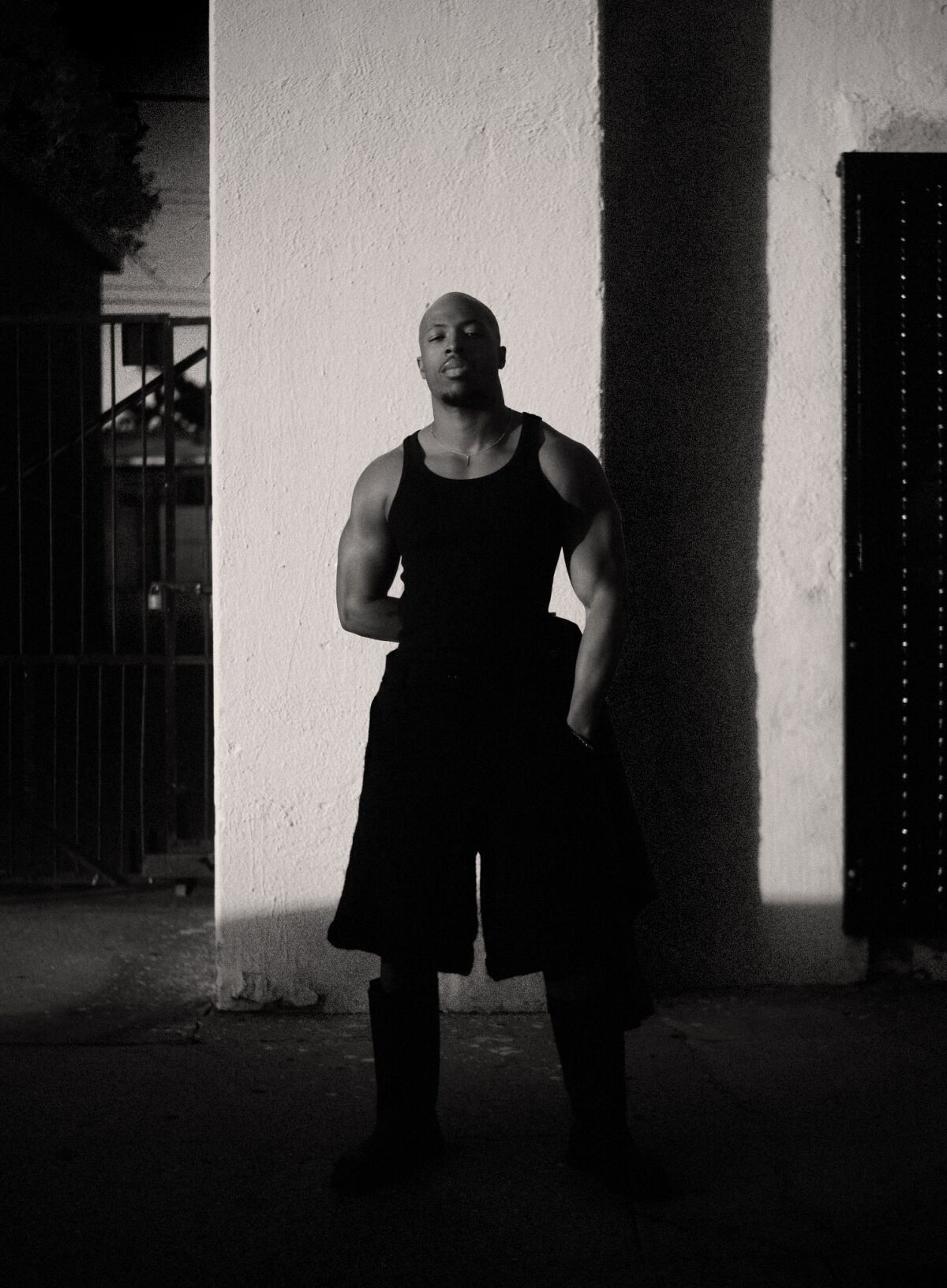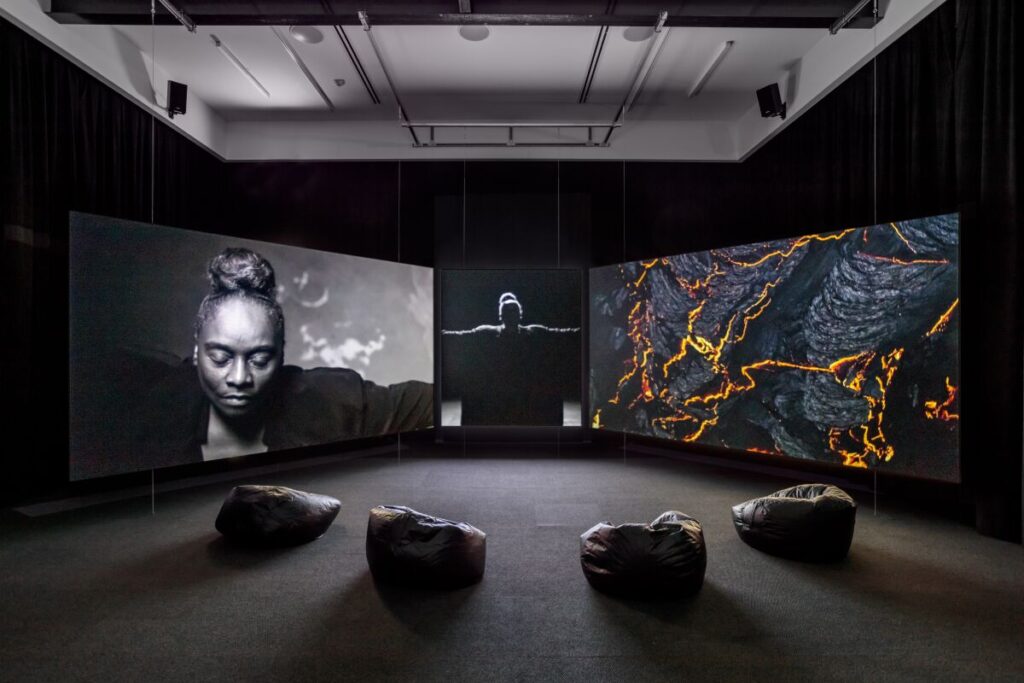Growing up in Crenshaw in the 1990s, Justen LeRoy was surrounded by the sounds of Destiny’s Child at the beginning of each “Proud Family” episode on Disney Channel, and of R&B artists who performed back-to-back on MTV. LeRoy bought his first CD, Brandy’s “Never Say Never,” when he was around 3 years old. Later, the now-shuttered Tower Records in Torrance became his go-to spot for browsing albums.
LeRoy, now an artist and a musician, describes Crenshaw itself as “the backbone” of his childhood — he grew up on Crenshaw Blvd and W. 59th St, and he went to school at View Park Prep Middle School. Which is why LeRoy’s first solo multimedia exhibition, “Lay Me Down in Praise,” at Art + Practice in nearby Leimert Park, is a full-circle moment. Curated by the California African American Museum’s visual arts curator, Essence Harden, as part of the CAAM at A+P collaboration, the work is up alongside several separate exhibitions: Chloë Bass’ “#sky #nofilter: Hindsight for a Future America” and Thaddeus Mosley’s “Forest.”
Justen LeRoy’s Art + Practice exhibition is up through late January.
(Joshua White)
For the record:
1:10 p.m. Dec. 20, 2022An earlier version of this story said Essence Harden, visual arts curator at CAAM, curated “Lay Me Down in Praise” at Art+Practice without noting that it’s part of the CAAM at A+P collaboration. It also used incorrect pronouns for them.
LeRoy’s exhibition is a three-channel film installation that implements clips of Black performers in communion with one another — hugging, sitting, breathing or moving in unison on film to the sounds of R&B songs. The clips are juxtaposed with images of geological activity like erupting volcanoes, earthquakes and roaring oceans. Together the images, along with the sound, envision what Black environmentalism, or the advocacy for Black people to occupy space and build a stronger relationship with nature, could be like. Through his work, LeRoy aims to connect sounds rooted in the Black community with climate change through themes of resistance and regeneration.
“Lay Me Down in Praise,” the exhibition’s title, began as a song that LeRoy created with his collaborator Hadyn in 2019. (He ultimately scrapped the song but kept the title.) LeRoy worked with Fred Moten as “thought partners” through the Underground Museum and BLKNWS, and during the process, he was drawn to the “wordless moan,” a musical technique connected to the gospel style.
In his essay “Black Mo’nin,” Moten points to Anthony Heilbut’s “The Gospel Sound” which explains that the wordless moan is meant to describe the indescribable — a sound to communicate what words can’t. For LeRoy, this idea resonates with the concept of melismas, or a group of notes sung as one syllable that often express a feeling without words, that is also often used in gospel music. It could be “a sigh, a cry and a scream,” as he describes. Through LeRoy’s research, he connected the wordless moan to the moaning of trees created from the abuse they receive — through rustling, deterioration and destruction.
“Justen LeRoy: Lay Me Down in Praise” exhibition at Art + Practice Sept. 17-Jan. 21.
(Joshua White)
“In my relationship with the community throughout my entire life, we’re not talking about climate change or what’s going on with the earth because we’re all thinking about everyday survival,” he says.
He first pitched the idea to Harden, a friend he made while working at the Underground Museum — which closed earlier this year. LeRoy feels it was “bold” of him to ask Harden to consider the idea, given that he’d never put on an art show before. Harden knew he could deliver.
“So much of curating is just about building trust between artists and curators, and holding space for each other,” says Harden, who uses they/them pronouns. “I did it because I knew him, and I knew his own ethic around work and care.”
What resulted from the pitch was the 20-minute film available for viewing at Art + Practice until late January 2023. Harden says they hope that the video will travel elsewhere so more artgoers can experience it. “I would love for this film to be shown, not only in the U.S., but I hope there’s a relationship to the diaspora that’s really strong,” they say.
The exhibit is not only LeRoy’s first solo show but also his first film. He collaborated with Kordae Jatafa Henry, who co-directed and edited “Lay Me Down in Praise.” Henry helped plan the logistics of the production and LeRoy materialized his vision for the film. “He really gave me the confidence on set to feel like I ran the show,” LeRoy says of Henry’s mentorship. LeRoy says the process let him develop his visual language as he pushed himself to learn alongside the seasoned team of filmmakers. Together, they filmed clips of Black performers and LeRoy collected the movements of the earth from ArtGrid, an archive that gathers contributions from cinematographers.
After filming in July, he went into the studio with Hadyn to work on the score, collecting trilling melismas from musical artists Moses Sumney, Diana Gordon and Nadiah Adu-Gyamfi. They collected about 16 minutes of singing from each artist, then chopped and synced their voices play behind visuals of crashing waves and erupting volcanoes playing next to images of Black people moving together. Their voices released stretched-out hums, moans and screams that flowed and collided with each other. Trilling high-pitched notes swayed over a deep hum that evolved into a groan, all while tectonic plates crashed on screen.
An installation view of LeRoy’s exhibition.
(Joshua White)
“What does the earth sound like?” LeRoy questions throughout the piece. “What might the Atlantic Ocean really sound like when we think about the slave trade and all the beings at the bottom of the ocean? What is that song?”
He looks to R&B for the answers. “My whole goal has been to bring R&B into the art canon,” LeRoy says. “I think we’ve intellectualized jazz down to the bone, but I think that R&B is as formative to our being.”
He adds, “It is really a vessel brought here to connect so many of our experiences through emotion.”
While music is his main love, LeRoy gravitated toward art while attending UC Irvine, while learning about Black contemporary art through Tumblr. He went to his first contemporary art museum, MOCA, at the age of 20 in January 2015. About nine months later he started working at the museum as a gallery attendant. He then moved on to the Underground Museum where he worked for about six years in various positions. He also curated the 2022 Noah Davis show with Helen Molesworth.
Through his initial journey in the art world, he found himself “hiding behind other occupations.” As the Underground started to dissolve, the calling to create art grew stronger.
“I knew that I could be doing the thing I’m doing now, and I didn’t feel supported enough to really achieve that while in college, or I didn’t see the pathway to get me there,” he says.

Justen LeRoy poses for a photo.
(Kadeem Johnson)
For a long time, LeRoy says he primarily looked for financial stability and was too preoccupied with surviving to envision a career in art. While he had an interest in the discipline, he felt there was no avenue or community that supported his endeavors. “The things that I didn’t have made me want more,” he says.
In early 2019, he decided to step out of the background and ended up performing at MOMA in April of that same year with composer and playwright Klein. In the following year, LeRoy was included in the Hammer Museum’s Made in L.A. 2020 exhibition with “SON.” — an audio piece that documents distinct and diverse facets of Black life.
He commemorates career-defining moments like these to his community of friends and supporters that he calls his home. It’s people like Sumney, Klein, Henry and Harden who remind him of his ability, simply by bearing witness in each other’s talent.
“Hiding wasn’t really helping me evolve much,” LeRoy says. “The biggest challenge is stepping into my power, into my purpose, and acknowledging that I’m worthy of having a show, worthy of making an album. I’m worthy of people showing up for me.”
‘Justen LeRoy: Lay Me Down in Praise’
Where: Art + Practice (A+P), 3401 W. 43rd Place
When: Tuesday to Saturday, 2 to 5 p.m. through Jan. 21
Cost: Free
Info: (323) 337-6887, artandpractice.org

